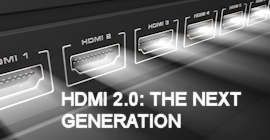Help > HDCP Dilemma
The HDCP Dilemma: What you need to know
What is HDCP and why do I care?Just when you thought buying the NEWEST and FASTEST 4K HDMI cables would solve all your issues, another digital dilemma strikes. With the introduction of 4K Ultra HD TVs, the industry - led by Intel Corporation (the patent holder of HDCP technology) - "upgraded" their encryption technology from version 1.2/1.4 to 2.0 and then immediately to version 2.2.
HDCP - High-bandwidth Digital Content Protection - was invented to prevent the copying of digital audio and video from an authorized source - such as a BlueRay player, to an UN-authorized destination - such as a BlueRay "burner". Unless all devices had this special HDCP circuitry, the signal can not be passed. Nearly all mainstream devices in the past 12 years have used HDCP version 1.2 or 1.4. Both versions were backwards compatible. Very few incompatibility issues arose, and the A/V world was happy.
Like any encryption technology, version 1.2 and then 1.4 was ripe for "hacking", and in 2010, researches determined that this version of HDCP could easily be by-passed, and in fact copying of digital content was rampent. A complete new version of HDCP was developed using completely different encruption algorthyms needing completing new circitry for any audio/video devices. The industry decided to release HDCP v2.0. Well, v2.0 was short lived (6 months), and immediate fixes were introduced in August of 2015. HDCP v2.2 is now the new defacto standard for all NEW audio/video devices supporting Ultra HD 4K technology.
The Dilemma?
Why is this change in HDCP versions so important? Because this created the following "rule" for our audio/video devices:
| The RECEIVING device of a signal must be same HDCP version OR higher than the original SOURCE device’s HDCP version |
However, if you use an older BlueRay player, satellite box, or media player that outputs 1080P and uses the older HDCP 1.2 or 1.4, you CAN successfully connect this to your newer 4K TV that supports the newer HDCP 2.2.
Some companies will be able to provide a firmware update for HDCP 2.0 and 2.1 to the newest version 2.2. However, devices using HDCP v1.2 or v1.4 can NOT be upgraded. They will need replacing in order to work with HDCP v2.2. Such older devices will ONLY need replacement if the SOURCE device is at a lower version number compared to the RECEIVING device. The following table will attempt to guide compatibility:
| Example Source Device |
HDCP Converter Needed? |
Home Theatre Receiver, HDMI Splitter, Matrix Box, or Switch |
HDCP Converter Needed? |
Receiving HDTV Supports... |
| 1080P BlueRay HDCP 1.2 | No | HDCP 1.2 | No | HDCP 1.2 (Most 1080P TVs) |
| 4Kx2K BlueRay HDCP 2.2 | Yes | HDCP 1.2 | No | HDCP 1.2 (Most 1080P TVs) |
| 4Kx2K BlueRay HDCP 2.2 | No | HDCP 2.2 | Yes | HDCP 1.2 (Most 1080P TVs) |
| 1080P BlueRay HDCP 1.2 | No | HDCP 1.2 | No | HDCP 2.2 (Most NEWER 4Kx2K Ultra HD TVs |
| 4Kx2K BlueRay HDCP 2.2 | Yes | HDCP 1.2 | No | HDCP 2.2 (Most NEWER 4Kx2K Ultra HD TVs |
| 4Kx2K BlueRay HDCP 2.2 | No | HDCP 2.2 | No | HDCP 2.2 (Most NEWER 4Kx2K Ultra HD TVs |
| 1080P BlueRay HDCP 1.2 | Direct Connect via HDMI | No | HDCP 1.2 (Most 1080P TVs) | |
| 1080P BlueRay HDCP 1.2 | Direct Connect via HDMI | No | HDCP 2.2 (Most NEWER 4Kx2K Ultra HD TVs | |
| 4Kx2K BlueRay HDCP 2.2 | Direct Connect via HDMI | Yes | HDCP 1.2 (Most 1080P TVs) | |
| 4Kx2K BlueRay HDCP 2.2 | Direct Connect via HDMI | No | HDCP 2.2 (Most NEWER 4Kx2K Ultra HD TVs |
* "Direct Connect via HDMI" - Means that the source device (such as a BlueRay Player) is connected using an HDMI cable directly to the HDTV without any additional A/V equipment in the middle






